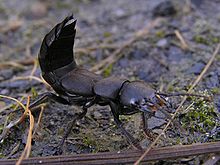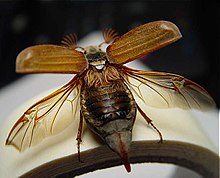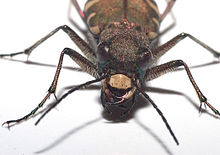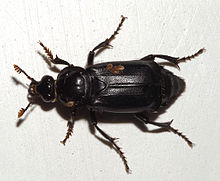Beetle
![]()
This article is about the insect order of beetles. For other meanings, see Beetles (disambiguation).
The beetles (Coleoptera) are the world's largest order of insects, with more than 350,000 described species in 179 families - hundreds of new species are still being described every year. They are distributed on all continents except Antarctica; about 8000 species occur in Central Europe. The oldest fossil beetles found to date date from the Permian period and are about 265 million years old.
The physique of the beetles differs from that of other insects in that the apparent tripartite division does not correspond to the head, the thorax and the abdomen, but the second section consists only of the prothorax, of which only the cervical shield is visible on the upper side of the body. The remaining two sections of the thorax form a unit with the abdomen and are covered by the sclerotized first pair of wings, the coverts.
With a length of about 170 millimeters, the giant longhorned beetle (Titanus giganteus) from Brazil is the largest beetle species; the goliath beetles, weighing about 100 grams, are among the heaviest insects of all. In Europe, the size of the beetles varies between about 0.5 and 75 millimetres; the largest Central European beetle is the stag beetle (Lucanus cervus).
Etymology
The word beetle has Germanic language roots. Already in the 9th century we find the word cheuur, in the 10th century chefuar, a century later we find the expressions cheuove, cheuer and keuir. However, they did not refer to beetles, but to grasshoppers. From the 13th century the word kever is attested, word-related with pine. Both words are derived from a root meaning "to chew, to gnaw". Only in the following centuries did the meaning of the word kefer change from "locust larva" to "beetle". The Germanic peoples also used the word webila for beetles. In the 11th century the word wibil appears, in the following century wibel, which lives on in English in the form weevil as a designation for the weevils as well as in dialectal names such as Perdswievel for horse beetles. Early on, distinctions such as scaernwifel and tordwifel are found for dung beetles, and in the 15th century various beetle families are already linguistically distinguished.
The scientific name Coleoptera comes from the ancient Greek. With κολεός (koleos) the leathery cover was designated, in which the sword was put, and with πτερόν (pteron) the wing. The leathery-looking cover-wings of the beetles, which partially enclose the hind wings, led to the naming.
Features of the beetles
The body shape of the imagines is very diverse and varies from very long and slender to stocky, short species. There are very flat to strongly spherical shaped bodies. The body shape is an adaptation to the way of life of the respective species. Thus, beetles living under loose bark are always flat; water-dwelling species, especially fast swimmers, have a streamlined shape; climbing beetles, whose escape behaviour consists of dropping in case of danger, are spherical. The texturing of body surfaces also varies widely. They range from smooth and shiny to highly textured surfaces with wrinkles, pits, grooves and humps. A decisive evolutionary factor for the formation of the body shape is, especially in bizarrely shaped species, the function of camouflage from predators.
The body structure of beetles follows the basic structure of insects. The body consists of three sections: head (caput), chest (thorax) and abdomen. However, the visible division in beetles does not correspond to head, thorax and abdomen. The second visible section consists only of the first segment of the thorax, the second and third segments form a unit with the abdomen, which is covered by the covering wings (elytra). The elytra are the first, heavily sclerotized pair of wings that protect the second pair of wings. On the ventral side, the posterior parts of the thorax project beyond the first abdominal segments, so that here, too, the second and third thoracic segments form a visual unit together with the abdomen. Beetles have, with few exceptions, a strongly sclerotized exoskeleton with the participation of chitin. Like all insects, they have six legs and two antennae as extremities, although the shape of these varies greatly from species to species. Beetles are insects with chewing mouthparts. Like all insects, they have a corded nervous system, but modified in that there are no longer any ganglia in the abdomen. The vascular system is open and has a tubular heart. The simple digestive tract with Malpighian vessels and the tracheal system for respiration also conform to the general plan of insects. However, there are deviations from this basic structural plan in almost all areas of beetle anatomy due to the diversity of beetles caused by the long evolutionary period.
Height
The body size of the beetles is limited upwards by the fact that the air must be transported through the tracheal system to the organs. The largest beetles are therefore relatively sluggish. Downwards, the body size is only limited by the fact that the relatively complex body structure can still be realized. The species of dwarf beetles (Ptiliidae) and spotted beetles (Clambidae) are among the smallest beetles and among the smallest insects of all; there are species that grow to less than 0.5 millimeters in length. Fire beetles (Pyrochroidae) and oil beetles (Meloidae) are families with very large species on average. However, the largest species worldwide belong to the longhorn beetles (Cerambycidae) and rose beetles (Cetoniinae). Within these families, however, there are large differences in length; the smallest longhorned beetle is only about three millimeters long, while the giant longhorned beetle (Titanus giganteus) is the largest known beetle species at all, with a length of about 170 millimeters. Also the body size of representatives of one species can vary considerably, for example the body length of the musk beetle varies between 13 and 34 millimetres. Since the imagines can no longer grow, such differences in size are solely due to different favourable living conditions during the larval stages. There are also sometimes, but rather rarely, considerable differences in size between the sexes of the same species. Strikingly larger males are found, for example, in the stag beetles, where the males engage in territorial fights. Mostly, however, the female is the larger sex.
Coloring
The coloration of the beetles is as varied as their body shape. Although most beetles are dark or colored in shades of brown; there are numerous species with patterned, brightly shining or metallic shining bodies. The coloration is caused by pigmentation or by structural colors.
The usually shiny metallic colour is caused by physical phenomena such as interference or scattering. This often occurs with thin-layered structures such as hairs (setae) or scales, or with special layering of layers of parallel chitin fibers. The coloration of the hairs and scales often covers the basic color. Patterns can be created by the base colour standing out in hairless or unscaled areas. Often older animals, in which the hair has disappeared, look different than freshly hatched animals. At the same time, freshly hatched beetles are usually not fully coloured in the first hours. In many species, males and females are differently coloured (sexual dichroism).
In some beetle species, a striking constancy of patterning is apparent, whereas in others there is a strong variability. In the ladybirds (Coccinellidae), for example, there are species that produce hundreds of different pattern and colour variants. These animals used to be given their own aberration names, if not treated as separate species, and thus placed in the status of systematic groupings. These assumptions, however, are now scientifically obsolete; most such designations are no longer in use. At the other extreme, for example, in the genus Trichodes of the family of the stain-beetles or in the genus Clytus of the family of the longhorned beetles, the patterns are almost the same in the different species. The coloration of the animals is often also an important characteristic for their camouflage and defense (see Camouflage and defense below).
Head
The head is the center of the nervous system of animals. It contains the two major concentrations of neurons, the superior cerebral ganglion and the inferior cerebral ganglion, which together are called the brain. In addition, many sensory organs are also located in the head, although not all. The most important parts are compound eyes, antennae, and mouthparts. The head capsule, which protectively encloses the brain, consists of an acron (head lobe) and six intergrown segments. The shape of the head can vary greatly depending on the species. There are round to angular and short to extremely elongated head shapes. In some species, the head may be extended forward by a large head shield. The head is divided into several areas:
| Designation | Position |
| Forehead (Frons) | front area |
| Temple (Tempus) | between the eye and the back of the head |
| Cheek (Gena) | side of the head in front of the eyes and the top of the head |
| Vertex | Top of the head behind the eyes |
Mouth parts
The beetles have chewing mouthparts. These represent the most original form of mouthparts, in which the relationship to the head legs of crustaceans is still recognizable. Nevertheless, they show a high degree of specialization in the respective mode of feeding. They consist of paired mandibles (upper jaw) and paired maxillae (lower jaw) as well as an unpaired labium (lower lip). The labium consists of an unpaired basal piece that functions as the lower lip. Then follows upwards the unpaired tongue (glossa) with the two secondary tongues (paraglossae). Towards the top, the mouthparts are completed by the labrum (upper lip), an unpaired plate. The mandibles are the most important tools for food acquisition. They are used by herbivores to cut off and crush plant parts; predators can use their pointed and sharp mandibles to grasp their prey, hold it, and break it into eatable portions. A few species cannot use their mandibles to acquire food. In male stag beetles, for example, they are so enlarged that they are useless as feeding tools. Instead, they are transformed into weapons with which males rivaling for females fight and with which to impress. On the maxillae as well as on the lower lip there are palpi, on which the sense of taste is located.
Probe
The antennae of the beetles arise from the head. The position of their insertion point (between or in front of the eyes, inside or behind the root of the maxillae and the like) often plays a role in identification keys. The antennae, as in all insects, are formed as flagellar antennae, having only one basal or also shaft member with musculature, the scapus. The following turning limb, the pedicellus, is movable together with the flagellum in relation to the scapus. Altogether the antennae consist of five to twelve limbs, depending on the family, but most of them have ten or eleven limbs. They are extremely variable in shape. In some families the males have differently shaped antennae (usually larger and longer) than the females. The basic types are thread-like (e.g. in ground beetles), clubbed at the end (weevils) or fanned (cockchafer) and combed (stag beetle) antennae. Regardless, a feeler is called "kneed" when it is angled. However, numerous gradations occur between these basic forms. The point of articulation and the construction of the antennae are often characteristic of a family or other systematic unit. On the antennae sit organs with which the animals can smell, but they are also organs of touch with which they orientate themselves. In some families they are also used to hold the sexual partner in the mating position.
Eyes
The eyes are formed as compound eyes. They are composed of single eyes (ommatidia). In addition to the basic type of apposition eye, the simplest complex eye, in which each individual eye is separate and optically isolated from its neighbors, there are also so-called superposition eyes, especially in crepuscular and nocturnal beetles. In these, the individual eyes are not optically isolated, but the light rays can also reach neighbouring ommatidia and stimulate the visual pigments of the rhabdomeres there to transmit the information of the light stimulation to the optic nerve. This enables vision even at lower light intensity and increases the perceived brightness many times over, but at the expense of visual acuity. At higher light intensity, the pigment cells can shift, again functionally creating an apposition eye. The eyes of beetles are not always circular. Most often they are kidney-shaped around the base of the antennae. In extreme cases, such as in many longhorned beetles, these "kidney halves" are separate.
A special case is present in the tumbling beetles (Gyrinidae), which live in water. In these beetles, the halves of the eyes are moved apart, the upper halves forming a pair of eyes above the water level, the lower halves of the eyes forming a pair of eyes below the water level. This allows them to see above and below water simultaneously, with their respective pairs of eyes adapted to the different light intensities, wavelengths, and refractive indices of air and water. A few beetle families, such as the bacon beetles (Dermestidae), have only simple dot eyes, as do beetle larvae, while other, cave-dwelling species have completely regressed eyes. These include several representatives of the ground beetles (Carabidae), each of which is endemic to only one cave, or for example the Segeberger cave beetle from the sponge beetle family.
Chest (Thorax)
The thorax of beetles consists of three parts: Prothorax, Mesothorax and Metathorax. From above you can only see the first section, the prothorax. This is covered by the neck shield (scutum). The other two thoracic segments are hidden under the elytra, except for a small part of the mesothorax. This scutellum, if any, is visible between the elytra at their base as a small triangle. From below, the three thoracic segments are visible, but not easily recognizable as such. This is because they consist of several sclerotized chitinous plates, which may be displaced from each other, so that plates belonging to the foregut come to lie between those of the midthorax. In particular, the plates of the hind breast project at least above the base of the abdomen, so that even the demarcation from the abdomen is not easily recognizable and the middle and hind breast appear to belong to the abdomen. At each of the three thoracic segments a pair of legs arises, at the rear two segments additionally the two pairs of wings arise.
Legs
The legs have the same basic structure as in other insects. Each leg is divided into several sections - hip (coxa), thigh ring (trochanter), thigh (femur) and splint (tibia) - and has two to five-limbed feet (tarsi) at the end, the last tarsi being provided with claws. The number of tarsal limbs is used for basic classification of beetle families. For example, 5-5-4 means that the hind legs have four tarsal limbs, and the other legs have five. The tarsal limbs, as well as the other leg segments, can vary greatly in length and shape. Individual segments can be so small that they are hidden in the preceding limb, like the fourth tarsal limb of the longhorn beetles (Cerambycidae). Often the legs are also broadened. In the green false longhorn beetle (Oedemera nobils) this is the case to such an extent that the legs appear almost spherical. The legs are specialized depending on the beetle species and use, and may be developed as running legs, jumping legs, swimming legs, or digging legs. The Australian sand-running beetle, Cicindela hudsoni, achieves a top performance in the insect class, with a running speed of up to 2.5 meters per second. Yellow blister beetles (Dytiscus marginalis) can swim up to 0.5 meters per second with their powerful webbed legs.
Wing
The defining difference of the beetles from the rest of the insects is the wing structure. In beetles, the first pair of wings differs markedly from the second. The forewings (elytra) arising from the middle thoracic segment are strongly sclerotized and essentially serve only to cover and protect the elaborately folded hind wings and abdomen. With few exceptions, they are folded obliquely forward during flight so that the rear pair of wings, which are capable of flight, can be unfolded. When closed, the inner edges of the coverts form the wing-coverlet seam. Towards the rear, however, they often gape apart. They are firm in most beetles, and in some, such as the weevils, they are even very hard. The soft-bodied beetles, on the other hand, have very soft cover-wings. The second pair of wings (alae) originates at the posterior thoracic segment and is formed as membranous wings, as in most flying insects. The hind wings are reinforced at the stabilizing wing veins and otherwise membranous. They unfold just before takeoff and are usually much larger than the elytra. After the flight they are usually folded again with the help of the hind legs and pushed under the cover wings.
The construction of the wings varies greatly. The wings can be of different length and either cover the abdomen completely or for the most part, or they leave the abdomen completely uncovered, as for example in the short-winged beetles. The two upper wings may also be fused, as in many ground beetles (Carabidae). The hind wings of these species are then usually atrophied or missing completely. The surface of the wings is sometimes very different. There are smooth, scaled, hairy and structured wings.
Abdomen
The abdomen consists of several, usually eight or nine visible segments. The hindmost abdominal segments are hidden in the body. The visible segments consist of two half-shell-shaped parts, the tergite on the back and the sternite on the abdomen. The two parts are connected laterally, parallel to the longitudinal axis of the body by the pleurite. The individual segments are connected by segmental skins. This makes the abdomen movable, unlike the rigid anterior body segments. However, the mobility is rather limited compared to most other insects. In some species, such as the genus Dytiscus of the family Dytiscidae, the abdomen is immobile. The short-winged beetles, on the other hand, are particularly good at moving the abdomen. In the threatening position they raise the end of the abdomen steeply upwards and thus appear much larger. The last abdominal segments contain the sexual organs.
Internal structure
The two main functions of the blood in vertebrates, transport of respiratory gases and of substances important in food metabolism, are performed in beetles, as in insects in general, by two different systems. The body fluid which performs the tasks of transporting food substances is called haemolymph. It does not flow in veins, but in interstices and body cavities, flowing around the organs of the beetles. The hemolymph contains no hemoglobin and may be colorless or yellow, but sometimes red or green. The only blood vessels are a short aorta and a tubular heart located in the upper part of the abdomen. The heart has eight paired lateral openings (ostia), corresponding to the number of abdominal rings, through which blood is drawn into the heart. The heart passes into the aorta, and the haemolymph is transported from the heart through it into the head. The transport is effected by a system of leaflet valves. However, no oxygen or carbon dioxide is transported; the gas exchange takes place via tracheas, which supply all organs with oxygen through their strongly ramified tube system. This is pumped into the body through lateral openings (stigmas), which can be clearly seen, for example, in the field cockchafer (Melolontha melolontha) when its abdomen makes distinct pumping movements before taking off. The maximum transport distance is limited in this respiratory system, which is also the reason why beetles and insects in general are limited in their size growth. The heart beats relatively slowly, for example in the stag beetle (Lucanus cervus) about 16 times a minute.
The nervous system is found on the abdominal side of the beetles, which is why it is also called the abdominal medulla. It deviates from the typical insect structure to a greater or lesser extent and is of unusual diversity within the order. The total of eight abdominal ganglia are sometimes displaced into the thoracic region. Depending on the species, all eight abdominal ganglia may remain separate (as in the basic structure of the Pterygota) (in Lycidae) or all, with the inclusion of the three thoracic ganglia, may fuse into a compact mass (in some weevils). The number of separate ganglia varies, for example, from two to ten in ground beetles, from one to five in weevils, and from two to seven in leaf beetles. The brain consists of a subclavian ganglion, an upper clavian ganglion, and another ganglion. It is altogether much smaller than the thoracic ganglion and lies below or above the oesophagus. The brain and thoracic ganglion are independent of each other, which is why the body can remain largely functional for some time after the loss of the brain.
The digestive system consists of an intestinal tract, which can be divided differently in different families. In carnivores it is relatively short, in herbivores it can reach ten times the body length. From the pharynx, the food passes through the oesophagus into the stomach. The following midgut has a long villous inner surface in the anterior section and a short villous inner surface in the posterior section. The rectum is divided into the small intestine (ileus) and the large intestine (rectum). In it, nutrients are absorbed into the blood. There, as well as in the two tubular kidneys (Malpighian vessels), metabolic products are absorbed from the organs and excreted through the anus. In some beetles, such as the bombardier beetles (Brachininae), there are glands in the colon whose secretions can be used for defensive purposes (defensive secretions).
The sexual organs in the male consist of paired testes, various glands, which can be built very differently in the respective families, and the draining ducts. The appendage glands and seminal vesicle also vary. A common excretory duct opens into the copulatory tools. Females have ovaries, appendage glands, and efferent vessels in various forms. A seminal pouch may be attached to the vagina, in which male semen is stored until oviposition. Mating and insemination may thus be separated by several months. Adhesives are occasionally used for egg-laying, for the production of which corresponding glands exist. The external sex organs are highly sclerotized, especially in the male. Their complex and species-specific form, which is highly specialized according to the lock-and-key principle, makes it possible to assign many beetles, which cannot be distinguished externally, to a well-defined species by genital examinations.

short-winged with threatening raised abdomen; well to recognize are the shortened cover-wings

Field cockchafer with forewings folded forward and posterior pair of wings unfolded

Like many longhorn beetles, the musk beetle has very long antennae.

The powerful mouthparts of the mountain sand beetle

Polyteles coelestina from South America

The three-division of the body is to be recognized well with the black gravedigger
Questions and Answers
Q: What order do beetles belong to?
A: Beetles belong to the order Coleoptera.
Q: How many named species of beetles are there?
A: There are approximately 350,000 named species of beetles.
Q: Are there more living species of beetles than have been named?
A: Yes, there are estimated to be between 800,000 and 1 million living species of beetles.
Q: Where can't beetles live?
A: Beetles cannot live in the ocean or in very cold places like Antarctica.
Q: What helped drive the diversification of beetles?
A: The evolution of flowering plants helped drive the diversification of beetles .
Q: Which four families mainly eat flowering plants?
A: Four of the six biggest families of beetles mainly eat flowering plants
Search within the encyclopedia